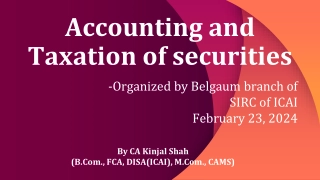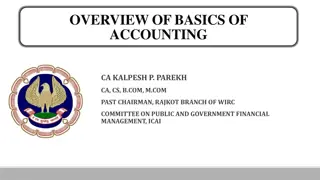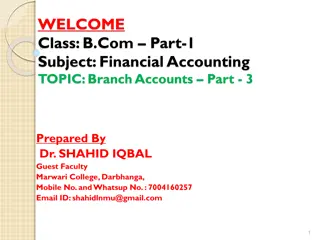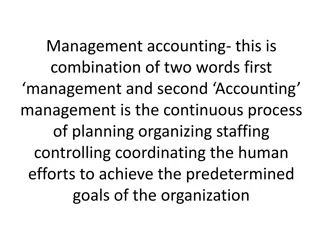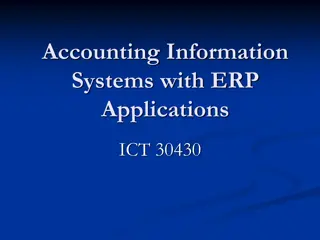Understanding Branch Accounting in Business Operations
Branch accounting involves managing multiple branches of a business separately to ascertain profits, financial positions, and performance. Dependent and independent branches have distinct features, with methods like debtors system used for accounting. This practice helps in controlling, expanding, or closing branches efficiently.
Download Presentation

Please find below an Image/Link to download the presentation.
The content on the website is provided AS IS for your information and personal use only. It may not be sold, licensed, or shared on other websites without obtaining consent from the author. Download presentation by click this link. If you encounter any issues during the download, it is possible that the publisher has removed the file from their server.
E N D
Presentation Transcript
Introduction: Branch Account A branch is a segment of a business. It is a chain of shops functioning in different localities under the control of the head office. The system of operating business at several places through one s own establishment s is called branch organization. Branch accounts are accounts relating to different branches and are used to ascertain the trading result of each branch separately.
Need or objectives of branch account The various objects of maintaining branch account are:- (1) To ascertain profit or loss of each branch. (2) To ascertain the financial position of each branch. (3) To help in controlling branches. (4) To assess the progress and performance of each branch. (5) To ascertain the requirements of stock and cash for each branch. (6) To ascertain whether the branch should be expanded or closed.
Types of branches Branches may be divided into (1) Dependent branches ( branch not keeping full system of accounting) (2) Independent branches ( branch keeping full system of accounting) (3) Foreign branches.
Dependent branches Dependent branches are branches, which don t maintain its own set of books. All records have to be maintained by the head office. The following are the features of such a branch: 1) These branches sells only such goods, which are supplied by the head office 2) The head pays all branch expenses 3) The branch manager out of petty cash book pays some petty expenses. 4) Such banks are instructed to deposit daily cash proceeds in to bank account opened in the name of head office 5) Sales are generally made on cash basis but some branches are authorized to make credit sales also. 6) Branches keep only some memorandum records 7) There are four methods of accounting for dependent branches namely a. Debtors system b. Stock and debtors system c. Final account system d. Wholesale branch system
DEBTORS SYSTEM Under this method, head office opens only one a ccount for each branch called branch account. Its purpose is to ascertain the profit r lo ss made by each branch. Such branch account is nominal in nature
Treatment of items in branch account (1) Branch expenses paid by branch from out of petty cash: - These need not be shown in the branch account. The opening balance of petty cash will appear on the debit side of profit and loss account. The cheque sent by the head office to the branch for petty expenses will also appear on the debit side. The closing balance of petty cash (i.e. opening+ amount sent by head office- petty expenses) will appear on the credit side. If petty cash is maintained on the imp rest system, actual expenses incurred will be reimbursed and appear on the debit side of branch account as to bank account
(2) Depreciation on fixed assets: - It is not shown in the branch account. The asset is shown on the credit side after deducting the amount of depreciation. (3) Bad debts, discount allowed etc: - These need not be shown in the branch account but appear on the credit side of debtors account. (4) Sales returns from branch debtors: - it will not appear on the branch account but appear on the credit side of debtors account. (5) Purchase of fixed assets by the branch: - The fixed assets purchased by the branch should be treated as closing branch fixed asset and should be credited to the branch account. If it is purchased for cash, it should also be deducted from the remittance on the credit side of the branch account. If it is purchased on credit, it should also be treated as a closing branch liability and appear on the credit side of branch account. (6) Sale of fixed assets: - The effect of this is to reduce the value of branch assets at close and increase the remittance from the branch in case the sale is for cash. If the sale is for credit it will increase the debtors balance instead of increase in remittance.
INVOICE PRICE METHOD Sometimes the head office may send goods at a price higher than the cost price. This inflated price is generally termed as invoice price. The difference between the invoice and the cost price is the loading. In this case three additional entries are also to be passed in addition to the usual entries.
Stock and debtors system In case of this system, the head office maintenance a number of accounts for branch transactions in place of in branch account. The various accounts are: 1) Branch stock account 2) Branch debtors account 3) Branch expenses account 4) Branch adjustment account 5) Branch profit and loss account 6) Branch cash account 7) Branch fixed asset account 8) Goods sent to branch account




